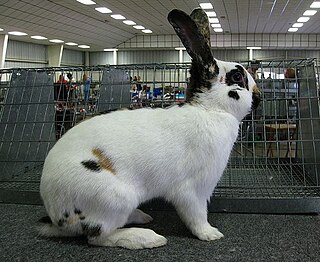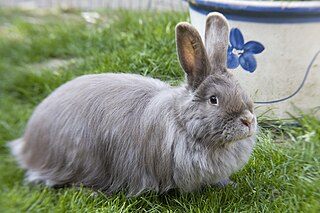Related Research Articles

The Angora rabbit, one of the most ancient groups of domestic rabbit breeds, which is bred for the long fibers of its coat, known as Angora wool. They are gathered by shearing, combing or plucking. Because rabbits do not possess the same allergy-causing qualities as many other animals, their wool is an important alternative. There are at least 11 distinct breeds of Angora rabbit, four of which are currently recognized by the American Rabbit Breeders Association (ARBA): the English Angora, the French Angora, the Giant Angora and the Satin Angora. Other unrecognized breeds include the German Angora, the Finnish Angora, the Chinese Angora, the Japanese Angora, the Korean Angora, the Russian Angora, the St Lucian Angora and the Swiss Angora.

The Netherland Dwarf is a breed of domestic rabbit that originated in the Netherlands. Weighing 1.1–2.5 pounds (0.50–1.13 kg), the Netherland Dwarf is one of the smallest rabbit breeds. Its popularity as a pet or show rabbit may stem from its neotenic appearance. The Netherland Dwarf is recognised by both the American Rabbit Breeders Association (ARBA) and the British Rabbit Council (BRC). The Netherland Dwarf is often confused with the Polish breed of rabbit, but the latter has longer ears, a non-brachycephalic head and less cobbiness.

The Californian, also known as the California White, is a breed of domestic rabbit initially developed for the fur and meat industries by George S. West of Lynwood, California, starting in 1923. West maintained a herd of 300 genetically pure New Zealand Whites, which he began crossing with Standard Chinchilla rabbits for their dense coat and Himalayan rabbits. This new breed, named after the state of its origin, was first shown in 1928, and a standard was accepted by the American Rabbit Breeders Association (ARBA) in 1939.

The Mini Lop is a breed of domestic rabbit that is recognized by the American Rabbit Breeders Association (ARBA). It is different from the Miniature Lop breed that is recognized by the British Rabbit Council (BRC). The Mini Lop [US] and the Miniature Lop [UK] are different from the Dwarf Lop breed that is recognized by the BRC. The Mini Lop is similar to several other small rabbit breeds, such as the Dwarf rabbit.

The Magpie is a British breed of domestic duck. It has distinctive black and white markings reminiscent of the European magpie, and is a good layer of large eggs.

The Checkered Giant, known as Géant Papillon in French, is a breed of domestic rabbit that originated in France. One of the largest rabbit breeds, the Checkered Giant is recognized by the American Rabbit Breeders Association (ARBA). The Checkered Giant is one of the minority of rabbit breeds with specific coat markings. The markings defined in the breed standard of the Checkered Giant differ somewhat from those in the breed standard of the Giant Papillon. For ARBA show purposes, a mature Checkered Giant buck must weigh a minimum of 11 pounds (5.0 kg), and a mature doe must weigh a minimum of 12 pounds (5.4 kg). ARBA does not specify a maximum weight for Checkered Giants.

The Argenté rabbit is one of the oldest breeds of French show rabbits. The British Rabbit Council (BRC) recognises six varieties: Argenté Bleu, Argenté Brun, Argenté Crème, Argenté de Champagne, Argenté Noir, and Argenté St Hubert. The American Rabbit Breeders Association (ARBA) recognises the Champagne d'Argent, the Crème d'Argent and the Argenté Brun. A rare variety, the Argenté Clair, is not currently recognised by either the BRC or ARBA.
The Cinnamon rabbit is a breed of domesticated rabbit created "accidentally" in 1962 and named for its coat color. The Cinnamon is currently recognized by the American Rabbit Breeders Association (ARBA) but not by the British Rabbit Council (BRC).

The New Zealand is a breed of rabbit, which despite the name, is American in origin. The breed originated in California, possibly from rabbits imported from New Zealand. New Zealand rabbits are available in five colors recognized by the American Rabbit Breeders' Association (ARBA): white, red, black, blue, and broken. Crossbreeding can result in many other variations, such as gold tipped steel and chestnut agouti. They average 10–12 lb (4.5–5.4 kg) with the does being slightly larger than the bucks. New Zealands are bred for meat, pelts, show, and laboratory uses, being the most commonly used breed of rabbit both for testing and meat production. They are also bred as pet rabbits but mostly breed for meat.
The Altex is a commercial breed of domestic rabbit developed, beginning in 1994, for cuniculture, specifically for the rabbit meat industry. The Altex breed is not recognized by the American Rabbit Breeders Association (ARBA) or by the British Rabbit Council (BRC).

The Rhinelander is a medium-sized breed of domestic rabbit that originated in Germany. Rhinelanders are known for their distinctive facial "butterfly markings", a spine marking, colored ears, cheek spots, eye circles and side markings of black with orange or of blue with fawn. The Rhinelander breed is recognized by the British Rabbit Council (BRC) and by the American Rabbit Breeders Association (ARBA).

The Blanc de Bouscat is a large white rabbit originally bred in France in 1906, with Argente Champagne, French Angora and Flemish Giant in its heritage. It is very rare in the UK and considered a breed at risk in France.

The Blanc de Hotot is a medium-sized rabbit breed originally developed in France. It is a compact, thickset white rabbit with spectacle-like black rings around each dark eye. First bred in Hotot-en-Auge, Normandy, France in the early 1900s, the breed spread throughout Europe and into North America by the 1920s. Initially unpopular in the United States, it died out there, and suffered population decline in World War II-era Europe. It began to spread again in the 1960s and 1970s, and was re-imported to the US in 1978. Today it is recognized by the British Rabbit Council and the American Rabbit Breeders Association, but is considered globally endangered, with a listing of "threatened" status by the American Livestock Breeds Conservancy.
The Lilac rabbit is a dove-blue coloured breed of domestic rabbit. A uniform pink shade of dove is called for by the breed standard, with matching eyes. Lilacs are mid-sized, docile and hardy rabbits. Developed in Great Britain in the early 20th century, the breed spread to the United States in 1922. Population numbers remain low enough that it is currently listed by The Livestock Conservancy as a breed to watch. The Lilac breed is recognized by the British Rabbit Council (BRC) and the American Rabbit Breeders Association (ARBA).

The Swiss Fox is a domesticated breed of rabbit originally bred for commercial use of their fur, but now kept mainly as pets. It is a recognised breed in the UK by the British Rabbit Council as a "Normal Fur" breed, however unrecognised by the American Rabbit Breeders Association making it a rare breed in the US.
References
- 1 2 3 Corridone, Roberto. "Bianco di Termonde - Blanc de Termonde". Istruzione agraria online ("Agricultural Education Online") (in Italian). Atlante delle razze di Conigli ("Atlas of Rabbit Breeds"). Retrieved 21 November 2022.
- ↑ Brown, Meg; Richardson, Virginia (1 April 2002). Rabbitlopaedia: A Complete Guide to Rabbit Care (pbk ed.). Ringpress Books Ltd. p. 119. ISBN 978-1860541827.
- ↑ "Breed Standards 2021-2025" (PDF). British Rabbit Council. Retrieved 21 November 2022.
- ↑ "ARBA Recognized Breeds". American Rabbit Breeders Association. Retrieved 21 November 2022.
- ↑ Bates, Ashley (25 July 2022). "Blanc de Termonde: Facts, Lifespan, Behavior & Care Guide (with Pictures)". Petkeen. Retrieved 21 November 2022.